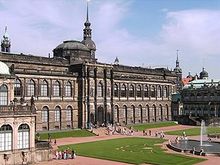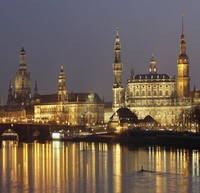It wasn’t so long ago that the cultural world was cheering Dresden, the one-time royal residence of Saxony rich in artistic splendor. Its historical center, all but destroyed in World War II, was lovingly rebuilt. The state art collections there are among the best in the world. Artists like Ernst Ludwig Kirchner and Richard Strauss worked there.
 Germany asked UNESCO to make the Dresden Elbe Valley a World Heritage Site, signifying its status as being of universal significance, and in 2004, UNESCO complied, citing (among other things) “Its art collections, architecture, gardens, and landscape features [which] have been an important reference for Central European developments in the 18th and 19th centuries” and its “exceptional testimonies of court architecture and festivities, as well as renowned examples of middle-class architecture and industrial heritage representing European urban development into the modern industrial era.”
Germany asked UNESCO to make the Dresden Elbe Valley a World Heritage Site, signifying its status as being of universal significance, and in 2004, UNESCO complied, citing (among other things) “Its art collections, architecture, gardens, and landscape features [which] have been an important reference for Central European developments in the 18th and 19th centuries” and its “exceptional testimonies of court architecture and festivities, as well as renowned examples of middle-class architecture and industrial heritage representing European urban development into the modern industrial era.”
 Now, that’s all over. Dresden is putting a four-lane bridge over the Elbe at a critical juncture and, at its recent meeting, UNESCO’s World Heritage Committee stripped Dresden of the honor. I applaud the committee, for finally getting some backbone, and said so in an opinion piece for Forbes.
Now, that’s all over. Dresden is putting a four-lane bridge over the Elbe at a critical juncture and, at its recent meeting, UNESCO’s World Heritage Committee stripped Dresden of the honor. I applaud the committee, for finally getting some backbone, and said so in an opinion piece for Forbes.
This is only the second time since the list was begun in 1972 that the committee has delisted a site. But UNESCO has few other tools to use with sites that are being exploited and ruined.
At its meeting last week in Seville, the committee also added 13 sites to the heritage list.
The thirteen, two natural sites and eleven cultural sites, include:
- The Stoclet House (left) in Belgium, commissioned by banker and art collector Adolphe Stoclet
-thumb-200x150-8294.jpg) from Josef Hoffmann, a leading architect of the Vienna Secession movement, in 1905. The house and garden were completed in 1911, “mark[ing] a turning point in Art Nouveau, foreshadowing Art Deco and the Modern Movement in architecture.”
from Josef Hoffmann, a leading architect of the Vienna Secession movement, in 1905. The house and garden were completed in 1911, “mark[ing] a turning point in Art Nouveau, foreshadowing Art Deco and the Modern Movement in architecture.” - The Sacred City of Caral-Supe in Peru, a 5000-year-old archaeological site located on a dry desert terrace overlooking the green valley of the Supe river. “Exceptionally well-preserved, the site is impressive in terms of its design and the complexity of its architectural, especially its monumental stone and earthen platform mounts and sunken circular courts.”
- The Royal Tombs of the Joseon Dynasty, in Korea — 40 tombs scattered over 18 locations and built from 1408 to 1966 in a landscape of outstanding natural beauty. “The grounds are adorned on the outside with a range of stone objects including figures of people and animals.”
A press release announcing all 13 is here, and one describing the Dresden delisting is here.
